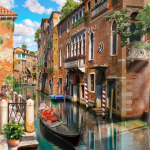A Step-By-Step Guide to Planning Your First Trip to Italy

Introduction
1. Determine the Best Time to Visit Italy
Choosing the right time to visit Italy is key to an enjoyable trip. Italy’s weather varies widely by region, so think about your preferences.
- Spring (April – June): Ideal for mild weather and fewer crowds.
- Summer (July – August): Best for beachgoers but expect larger crowds, especially in tourist hotspots.
- Fall (September – October): A favorite for many, offering pleasant temperatures and fewer tourists.
- Winter (November – March): Great for skiing in the Alps and experiencing Italy’s cities without high-season tourists.
When planning, use these Travel Tips for Italy: consider the weather, national holidays, and any events specific to regions, like Venice’s Carnival in February or Tuscany’s grape harvest in September.
2. Set a Realistic Budget
Creating a realistic budget is vital for a stress-free trip. Italy can cater to both luxury and budget travelers, so consider costs for flights, accommodation, transportation, food, and activities.
- Flights: Booking months in advance often helps reduce costs. Check deals and compare prices.
- Accommodation: Decide between hotels, Airbnbs, hostels, or agriturismos (farm stays).
- Food and Dining: Budget for diverse dining experiences, from local trattorias to higher-end restaurants.
- Excursions and Tours: Some attractions, like the Vatican and the Colosseum, may require advance bookings.
One of the key Travel Tips for Italy is to monitor your expenses daily. This will help ensure you stay within your budget and still have room for unexpected opportunities.
3. Choose the Cities and Regions to Visit
Italy offers a vast array of cities and regions, each with unique allure. For a first trip, consider a mix of cultural hubs and scenic escapes.
- Rome: The capital, famous for the Colosseum, Vatican City, and centuries of history.
- Florence: Known for its Renaissance art, museums, and nearby Tuscany’s vineyards.
- Venice: A romantic, canal-filled city that offers unique experiences but often draws large crowds.
- Milan: Italy’s fashion capital, perfect for shopping and architecture.
- Amalfi Coast and Cinque Terre: Coastal towns with breathtaking sea views, ideal for relaxation.
Use this Travel Tips for Italy suggestion: decide your primary interests—whether history, art, nature, or food—and align your destinations with them.
4. Learn Key Italian Phrases
While many Italians speak English, especially in tourist areas, learning a few Italian phrases will enhance your experience. Not only will locals appreciate your efforts, but it can also help in places where English isn’t common.
- Greetings: “Buongiorno” (Good morning) and “Buonasera” (Good evening)
- Polite phrases: “Per favore” (Please) and “Grazie” (Thank you)
- At restaurants: “Il conto, per favore” (The check, please)
- Asking for help: “Mi scusi” (Excuse me) and “Dov’è…?” (Where is…?)
Following these Travel Tips for Italy will help you navigate, communicate, and feel more at home in Italian culture.
5. Book Accommodations in Advance
Italy is a popular travel destination, and accommodations can fill up quickly, especially in summer and around holidays. Booking early secures you better options and rates.
- Hotels and B&Bs: Italy offers a wide range, from luxury hotels to budget-friendly B&Bs.
- Vacation Rentals: Airbnb and similar platforms offer charming apartments and villas, ideal for longer stays.
- Agriturismo: These farm stays are unique to Italy, offering a glimpse into rural life with authentic Italian meals.
One of the top Travel Tips for Italy is to book accommodation near public transport, especially in large cities, to make sightseeing easier.
6. Plan Your Transport Options
Getting around Italy can be straightforward, thanks to its efficient public transport systems. Trains are typically the best way to travel between cities, while buses and local transport work well within regions.
- Trains: High-speed trains like Trenitalia and Italo connect major cities, while regional trains service smaller towns.
- Buses and Metros: Italy’s cities have reliable buses and metro systems, perfect for urban travel.
- Rental Cars: If exploring the countryside, renting a car provides flexibility but consider local driving rules and costs.
- Vaporetti (Water Buses) in Venice: A unique mode of transport in Venice, offering scenic views of the canals.
For first-timers, a key Travel Tips for Italy reminder is to validate train tickets before boarding, as failing to do so can lead to fines.
7. Familiarize Yourself with Italian Dining Etiquette
Italian dining culture is different from many other places, and knowing the etiquette can enhance your experience.
- Dining Hours: Italians typically dine later, with lunch around 1-3 PM and dinner from 7-10 PM.
- Courses: A traditional Italian meal has multiple courses—antipasto, primo, secondo, contorno, and dolce.
- Tipping: Tipping isn’t obligatory in Italy, as service is usually included in the bill, but rounding up the change is appreciated.
These Travel Tips for Italy ensure you enjoy an authentic dining experience and interact with locals respectfully.
8. Book Key Attractions in Advance
Italy’s popular attractions can have long lines, especially during peak seasons. Book tickets in advance to avoid waiting and ensure you don’t miss out on top sites.
- Rome: The Colosseum, Roman Forum, and Vatican Museums (including the Sistine Chapel).
- Florence: The Uffizi Gallery and the Accademia Gallery to see Michelangelo’s David.
- Venice: The Doge’s Palace and a gondola ride.
- Milan: The Last Supper by Leonardo da Vinci, which requires booking months in advance.
One of the essential Travel Tips for Italy is to use official websites for booking to avoid markups and potential scams.
9. Prepare for Italian Shopping Customs
Shopping in Italy offers a fantastic range of products, from high-end fashion to local markets filled with handcrafted goods. However, understanding the customs can enhance your experience.
- Markets vs. Boutiques: Italy has both bustling street markets and exclusive boutiques. Always ask for “sconto” (discount) at markets but expect fixed prices in boutiques.
- Tax Refunds: Non-EU visitors can claim VAT refunds on purchases over a certain amount; remember to keep your receipts.
Incorporate this Travel Tips for Italy advice: familiarize yourself with customs regulations if you’re bringing goods home, especially wine or food.
10. Know the Basics of Italian Culture and Customs
Italian culture is warm and welcoming, but it’s respectful to understand local customs.
- Dress Codes: Dress modestly when visiting churches or religious sites.
- Punctuality: Italians can be more relaxed with timing, especially in social settings, but business meetings are typically punctual.
- Personal Space: Italians are known for friendly gestures, like kisses on both cheeks, but follow the lead of your Italian hosts.
This Travel Tips for Italy suggestion is to stay observant and adopt the local way of doing things; it will enrich your experience.
11. Understand Italy’s Electrical Outlets
Italy uses a 230V power supply with plug types C, F, and L, different from what’s common in many other countries. Pack a suitable adapter and check if your devices can handle the voltage.
One of the practical Travel Tips for Italy is to bring a universal adapter to charge multiple devices without hassle.
12. Pack Accordingly for Your Italian Adventure
Packing for Italy requires careful consideration, as the weather varies significantly between regions and seasons.
- Layered Clothing: Ideal for spring and fall when temperatures fluctuate.
- Comfortable Walking Shoes: Italian cities are best explored on foot, and cobblestone streets can be challenging.
- Sunscreen and Sunglasses: Essential in summer, especially for beach trips.
Packing with these Travel Tips for Italy in mind ensures you’re ready for various activities and climates.
13. Handle Money Matters in Italy
Italy uses the euro (€). While cards are accepted widely, having some cash on hand is helpful.
- ATMs: Use ATMs associated with banks to avoid high fees.
- Cash Payments: Smaller shops and markets may only accept cash, so carry small denominations.
- Currency Exchange: Avoid airport exchange counters; they often have high fees.
Among Travel Tips for Italy, remember to notify your bank of travel dates to prevent your card from being blocked.
14. Get Travel Insurance
Travel insurance offers peace of mind, covering medical emergencies, trip cancellations, or lost belongings. Look for a plan with adequate coverage and check if it includes COVID-related disruptions.
This Travel Tips for Italy recommendation emphasizes that travel insurance is a small investment for a safer trip.
15. Embrace the Italian Dolce Vita Lifestyle
Italy is all about savoring life. Don’t rush through your itinerary—take time to enjoy each meal, appreciate the art





